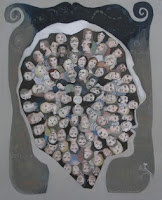A Social Account of Suffering

50,000 cultured brain cells sit in a petri dish. Through a combination of electronic sensors, software engineering and robotic sculpture , the physiology of the cells interacts with the psychology of some patrons of an art gallery [1]. From this transaction, judgments arise - the audience might report feelings of being watched, of play, or simply of remotely observing an oblivious 'seizure machine.' One particular type of audience member, the Animal Ethicist, might even wonder if we should be worried that the culture of brain cells (as a former animal) might be in pain. Brain cells, electrodes, and tiny Peter Singer (image from here ). While in most cases it is fairly straightforward to determine that a human is in pain, when one starts to asks if non-humans (or even humans with severe communication problems, such as locked-in patients) are in pain, it is common to turn to neuroscience for help. The idea is that while mental states (such as pain and suffering) can only b...



